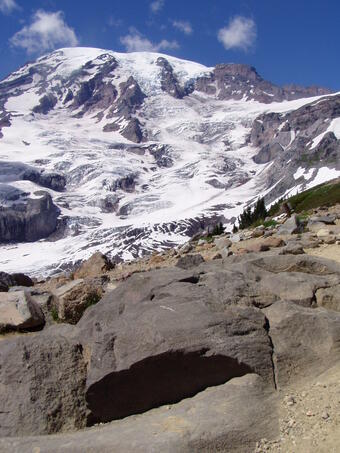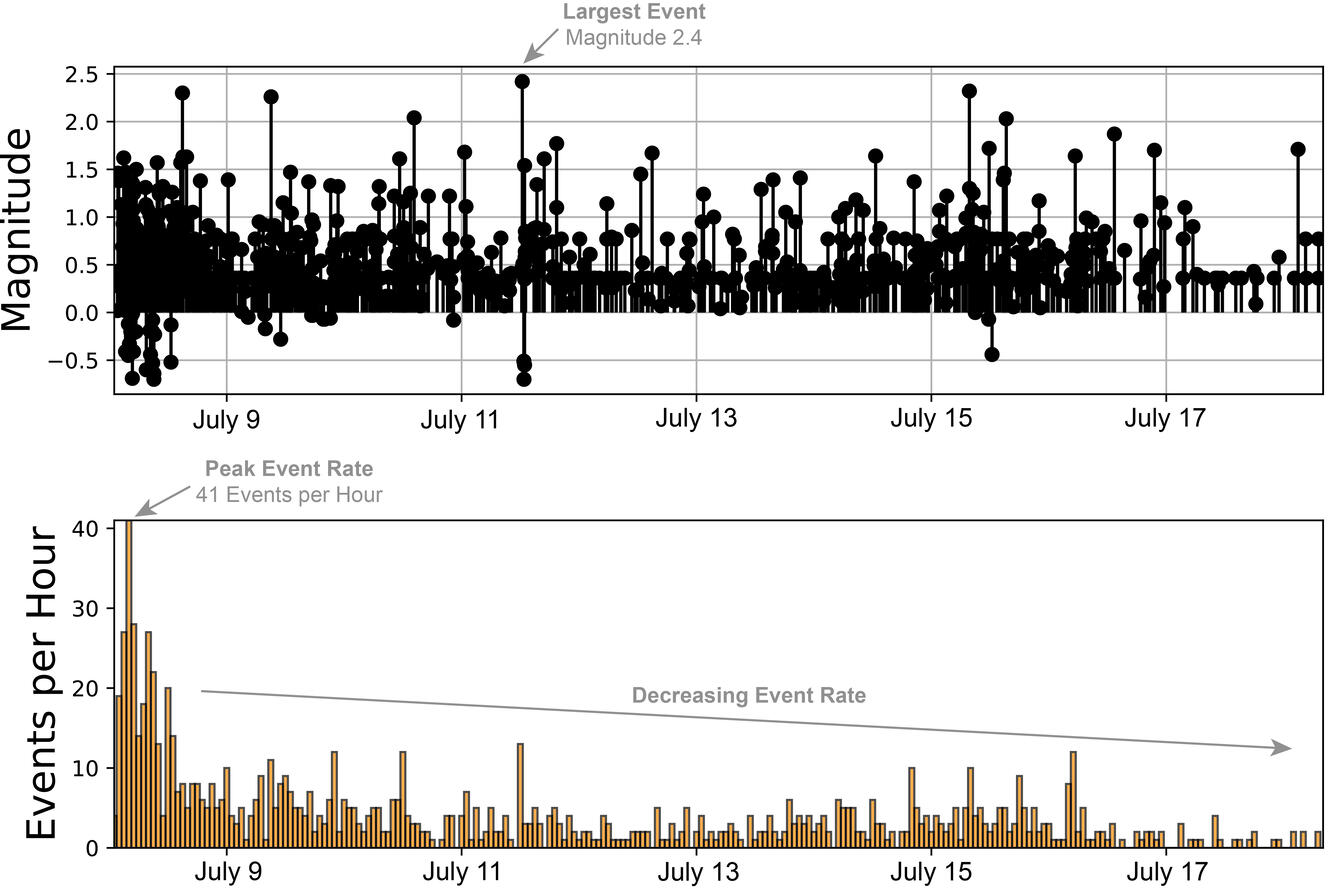Monitoring stations detect small magnitude earthquakes at Mount Rainier during July 2025
A swarm of small magnitude earthquakes is occurring at Mount Rainier (July 8-18, 2025)
An earthquake swarm that started at Mount Rainier on July 8, 2025, is the largest ever recorded at the volcano.
An earthquake swarm began at Mount Rainier, Washington, at 1:29 a.m. PDT (08:29 UTC) on July 8, 2025. An earthquake swarm is a cluster of earthquakes occurring in the same area in rapid succession. Currently, there is no indication that the level of earthquake activity is cause for concern, and the alert level and color code for Mount Rainier remain at GREEN / NORMAL.
The Pacific Northwest Seismic Network is in the process of looking at each earthquake and identifying its location, depth and size, if possible. This process is called locating. Some earthquakes are too small to locate. You can follow along in that process and watch the data on their website https://pnsn.org/volcanoes/mount-rainier.
This swarm consists of hundreds of very small earthquakes with the largest so far being a magnitude 2.4 at 12:23 p.m. PDT (19:23 UTC) on July 11, 2025. The Pacific Northwest Seismic Network has located 716 earthquakes as of 9 a.m. PDT on July 16; this number will increase as seismologists continue to analyze data. The earthquake rate has decreased over time, with a peak of 41 located events per hour on the morning of July 8 decaying to a few events per hour as of the morning of July 16. The earthquakes are mainly spread between 1.5-4 miles (2-6 km) beneath the summit. Earthquakes are too small to be felt at the surface and will likely continue for several days. There would be no damage caused by such small events.
Typically, earthquakes at this volcano are located at a rate of about 9 earthquakes per month. Swarms usually occur 1-2 times per year at Mount Rainier but are usually much smaller in terms of number of events. Earthquakes are one of several parameters we monitor to indicate what a volcano is doing. Right now, this swarm is still within what we consider normal background levels of activity at Mount Rainier. Past swarms have been attributed to circulation of fluids interacting with preexisting faults.
The last large swarm at Mount Rainier in 2009 had a maximum magnitude of M2.5 and lasted three days. This swarm surpasses the 2009 swarm in terms of total events, event rate, and energy release.
To receive updates, you can sign up for USGS volcano notifications here: https://volcanoes.usgs.gov/vns/.
FREQUENTLY ASKED QUESTIONS
What is an earthquake swarm?
An earthquake swarm is a cluster of earthquakes occurring in the same area in rapid succession.
Is this normal for this area?
Earthquakes are a common phenomenon beneath volcanoes, because there are often lots of water and heat beneath the volcano. Swarms, or clusters of earthquakes that are close in time and location are also common at volcanoes. Typically, earthquakes at this volcano are located at a rate of about 9 earthquakes per month. Swarms typically occur 1-2 times per year, but usually much smaller in terms of number of events. The last large swarm at Mount Rainier in 2009 had a maximum magnitude of M2.3 and lasted three days. PNSN officially located 120 earthquakes in that 2009 swarm, although many more occurred but were too small to locate.
While the swarm at Mount Rainier has more earthquakes than typical swarms we have seen at Mount Rainier, we have only monitored the volcano well since the late 1980's. Given that the least eruption was about 1000 years ago, we still have a lot to observe to understand the entire volcanic cycle at Mount Rainier.
What could these earthquakes imply?
These earthquakes are a reminder that Mount Rainier is an active volcano. Based on our observations, we think the most likely cause of the earthquakes is water moving around the crust above the magma chamber. This interpretation comes from observations of swarms on other volcanoes and observations of older swarms at Mount Rainier.
How strong was the largest earthquake in this swarm?
M2.4 is the largest, far too small to feel. Although future events could be stronger.
Is the USGS expecting any more earthquakes in this series?
The last large swarm at Mount Rainier in 2009 lasted for 3 days. Most swarms at Mount Rainier (there are 1-2 annually) last less than a week. That being said, we do not have a good estimate for how long this swarm may last, and whether it will intensify or peter out.
Do they pose any significant threat to people hiking on the mountain today?
No. These events are too small to feel and the shaking from these is too small to trigger any additional activity from cliff faces or glaciers. Warm temperatures on the volcano have occurred over the past couple of days that have caused an increase in rockfall and icefall that has been noted by Mount Rainier National Park. The current warm weather is not related to the swarm under Mount Rainier.
If this activity is still within the normal range for Mount Rainier, what would unusual look like?
The only data that we are noticing anomalous activity in are the increase in seismicity, with no notable deformation, infrasound, or changes in the webcams have been observed. If things were abnormal, we would expect the earthquakes to shallow or change their characteristics. The earthquakes are classic volcano-tectonic earthquakes, but a change in frequency content such as hybrid or low frequency earthquakes may be indicative of a change in activity.
If the swarm lasts more than a week or so, that would be different than the last large swarm at Rainier in 2009.
Is the volcano due for an eruption anytime soon? Or historically speaking?
No, the volcano is not “due” for an eruption and we do not see any signs of a potential eruption at this time.





